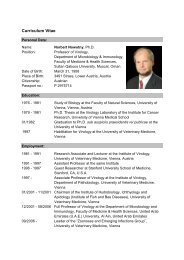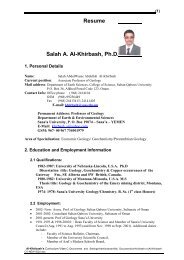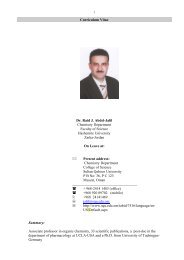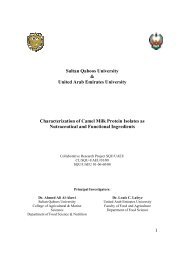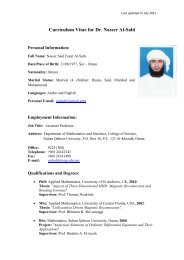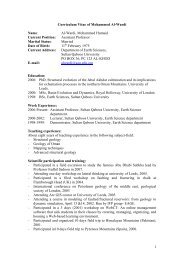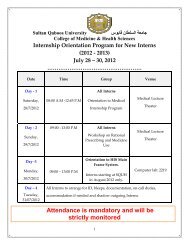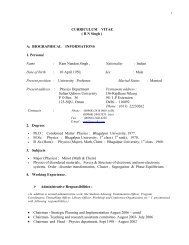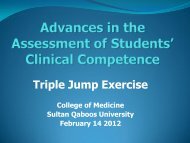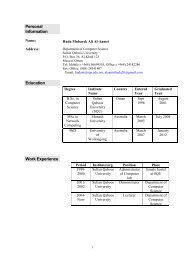264 - Sultan Qaboos University
264 - Sultan Qaboos University
264 - Sultan Qaboos University
Create successful ePaper yourself
Turn your PDF publications into a flip-book with our unique Google optimized e-Paper software.
Diversification of<br />
Omanʼs Economy<br />
Department of Public<br />
Relations and Information<br />
<strong>Sultan</strong> <strong>Qaboos</strong> <strong>University</strong><br />
News Update<br />
Career Fair Concludes<br />
Mind Over Matter<br />
Women Outshine in Medical Labour Force in Oman<br />
Panorama<br />
Muscat Book Fair: Does it Need Improvement?<br />
ISSUE <strong>264</strong>
View Point<br />
What we can do<br />
With the advent of so called globalization, everyday, millions of people<br />
cross international borders, and this has led to the spread of infectious and<br />
insect borne diseases from one country to another. There are numerous<br />
health problems that are of such magnitude that they have a global political<br />
and economic impact. Global health refers to health problems that<br />
are best addressed by joint actions and solutions—solutions that involve<br />
more than one country. Because global health problems can move across<br />
national borders, countries can learn from one another’s experiences, both<br />
in how diseases spread and in how they can be treated and controlled.<br />
Mohamed Salem Al Ghailani<br />
Editorial Supervision<br />
Humaid Abdullah Al Adwani<br />
Editor in Chief<br />
Santhosh Muthalath<br />
Senior Editor<br />
Ahlam Al Wahaibi<br />
Design & Layout<br />
Delivering a talk on Global Health at the College of Medicine & Health<br />
Sciences at SQU, Dr. Sibu Saha, Chairman, Directors Council, Gill Heart<br />
Institute, <strong>University</strong> of Kentucky School of Medicine, USA, pointed out<br />
that global health matters to everyone, not just to those living in developing<br />
countries. It is important that we address global health issues for the<br />
humanitarian, equity, and direct impact reasons.<br />
In 2002, while life expectancy at birth reached 78 years for women in developed<br />
countries, it fell back to less than 46 years for men in sub-Saharan<br />
Africa, largely because of the HIV/AIDS epidemic. For millions of children<br />
today, particularly in Africa, the biggest health challenge is to survive until<br />
their fifth birthday, and their chances of doing so are less than they were<br />
a decade ago. This is a result of the continuing impact of communicable<br />
diseases. At the same time, 36 million deaths each year are caused by noncommunicable<br />
diseases, such as cardiovascular disease, cancer, diabetes<br />
and chronic lung diseases.<br />
Rashad Al Wahaibi<br />
& Photography Dept., CET<br />
Photography<br />
Basheer Al Riyami<br />
& Salim Al Sudairi<br />
World Health Organization has ranked the <strong>Sultan</strong>ate of Oman as first in<br />
the world for its highly efficient health system and for effective and competent<br />
utilization of the available financial resources in health services.<br />
Oman was also rated eighth for providing the most comprehensive health<br />
care at the world level. It would be worthwhile if Oman could actively<br />
engage in sharing its experiences with other countries and international<br />
organizations in combating the latest challenges in global health.<br />
Distribution<br />
Horizon invites contributions from SQU members of staff and faculty. Contributions in the form of<br />
articles, news, travelogues, stories of unique and interesting experiences, encounters, etc., are welcome.<br />
Contributions may be edited for the sake of clarity and length. Please send your contributions<br />
to horizon@squ.edu.om preferably, as MSWord attachments. Authors will be suitably credited.<br />
The views and opinions expressed in the articles published in this newsletter are those of the authors<br />
and are not to be construed as the official views of the publication. Horizon is published three times a<br />
month by the Department of Public Relations and Information, <strong>Sultan</strong> <strong>Qaboos</strong> <strong>University</strong>, P.O. Box 50,<br />
P.C. 123, Muscat, <strong>Sultan</strong>ate of Oman.<br />
Phone: +968 24141045 Fax: +968 24413 391<br />
E-mail: horizon@squ.edu.om<br />
Website: www.squ.edu.om<br />
P2 20 March 2013
Big Turnout for Family Day<br />
News Update<br />
Career Fair Concludes<br />
A large number of people including employees, their family members and<br />
children, and SQU students turned up at the 8th Family Day, organised<br />
by the Social & Cultural Activities Section of the Department of Public<br />
Relations & Information at SQU. The event was held on March 7, under<br />
the patronage of H.E. Dr. Ali bin Saud Al Bimani, the Vice Chancellor. Several<br />
senior academicians and officials attended the event. The organizers<br />
were extremely pleased with this year’s big turnout for this annual event.<br />
Hundreds of students, employees and their children came out to the Male<br />
Sports Complex to enjoy an afternoon of fun and informative activities.<br />
The inflatable slide and jumps face painting and henna, live characters,<br />
and puppet show offered ample fun for the kids gathered at the venue.<br />
Another attraction was a magic show that entertained kids as well as<br />
adults. In the Communities Corner section, expatriate employees decorated<br />
booths to represent the history, social context, religions and cultural<br />
aspects of their own countries. Around 11 countries including Germany,<br />
France, Italy, Russian, Azerbaijan, Pakistan, India, Egypt, Sudan, Tunisia,<br />
and Syria were represented. A few booths provided the traditional<br />
food items of the respective countries to the visitors. Mohammed Salim<br />
Al Gheilani, Director of the Department of Public Relations and Information,<br />
said that the aim of this events is to encourage expatriate employees<br />
from different countries and their families to meet each other and get together<br />
with an array of cultural and entertainment activities. “The Family<br />
Day activities reflect the heritage and culture of the representing countries<br />
through the employees”.<br />
SQU Receives<br />
Iranian Diplomat<br />
As many as 58 organizations from the public and private sectors in Oman<br />
participated in the Career & Training Opportunities Fair, organized by<br />
the Centre for Career Development at <strong>Sultan</strong> <strong>Qaboos</strong> <strong>University</strong>. The<br />
opening ceremony of the event was held under the patronage of H.E.<br />
Sheikh Khalid bin Omar Al Marhoon, Minister of Civil Service.<br />
The Center for Career Guidance at SQU started organizing the annual<br />
Career & Training Opportunities Fair over 14 years ago, as part of ensuring<br />
the provision of job opportunities or training to the students and<br />
graduates of SQU at all levels of undergraduate majors. Another objective<br />
of this event is to build excellent relationships between the local,<br />
regional and international employers.The exhibition annually receives a<br />
large numbers of requests for participation from local and international<br />
companies, and is witnessing participation of more than 65 organizations<br />
from the government and private sectors. The organizations are selected<br />
on the basis of the number of positions available and their suitability to<br />
the qualifications and skills of SQU graduates.<br />
The Fair acts as a meeting place for the university students and the private<br />
and public sector organizations to be updated on the availability of<br />
job vacancies, training opportunities and training programs. It also helps<br />
to educate students about work atmosphere in the private sector through<br />
direct communication with HR managers. For the prospective employers,<br />
this is an opportunity to know the academic level, skills and competencies<br />
of the university students and establish a direct contact with the university<br />
through the Centre for Career Guidance.<br />
Japanese <strong>University</strong><br />
Seeks Ties with SQU<br />
H.E. Ramin Mehmanparast, Iran Foreign Ministry Spokesman visited <strong>Sultan</strong><br />
<strong>Qaboos</strong> <strong>University</strong> recently with a view to strengthen ties between<br />
Iranian higher educational institutes and SQU. H.E. Dr. Ali bin Saud Al<br />
Bimani, Vice Chancellor of <strong>Sultan</strong> <strong>Qaboos</strong> <strong>University</strong>, and H.H. Sayyidah<br />
Dr. Mona bint Fahd Al Said, Assistant Vice Chancellor for External Cooperation,<br />
received the Iranian diplomat.<br />
Both sides reviewed the existing collaboration between SQU and Iranian<br />
universities and agreed on extending the partnership to more universities<br />
through exchange of faculties, students and collaborative research in different<br />
fields including science, engineering and Islamic sciences. At the<br />
beginning of the discussion, H.E. Ramin Mehmanparast gave an overview<br />
of the higher education in Iran and expressed his keenness to see Omani<br />
students studying in Iran under scholarships from his country.<br />
H.E. Dr. Ali Al Bimani, received in his office, Prof. Kitaoka Shinichi, President<br />
of the International <strong>University</strong> of Japan. They explored the possibility<br />
of tie ups between the two universities through student exchange. Dr. Ali<br />
Al Bimani gave an overview of SQU, its academic programs, and alignment<br />
of the programs with the job market requirements in the country<br />
and abroad.<br />
Prof. Kitaoka Shinichi said that the academic programs in International<br />
Relations and International Management offered at the Japanese is a<br />
unique opportunity for students to deepen their understanding of the<br />
policy sciences and area studies, using cutting edge information and communication<br />
technologies.<br />
20 March 2013 P3
Insight<br />
Diversification of Oman’s Economy:<br />
Issues that Need Attention<br />
The Vision for Oman’s Economy: Oman 2020 aims at carrying out a substantial<br />
transformation in the structure of the national economy by developing<br />
a multiplicity of income sources. According to some experts, the<br />
need for oil sector most often seen as a depleting sector is a misnomer in<br />
the diversification field. Both oil and non-oil sector ought to be so linked<br />
as to sustain the Oman economy both on her indigenous resource, oil, and<br />
to develop the non-oil sector along with this, not in marginalization of<br />
the resource-based rich and reliable oil sector. Three senior academicians<br />
from the Department of Economics & Finance of the College of Economics<br />
& Political Science at SQU, share their views on diversification of the<br />
national economy.<br />
Consequences Matter: Prof. Masudul Alam Choudhury<br />
According to Professor Masudul Alam Choudhury, economic diversification<br />
means both product and risk diversifications that come about by<br />
expanding the allocation of economic resources, such as budget, markets,<br />
international export penetration, and diversity of sectors over which the<br />
resources and development can be spread out with many participating<br />
investors and stakeholders. “But economic diversification has also a very<br />
important consequence. This is generating complementary linkages between<br />
producing sectors. Such a design of the economy with healthy linkages<br />
between sectors causes each sector to use the output of other sectors<br />
as inputs to produce its own end products. As the products of inter-relating<br />
sectors increase, so also stakeholders like investors and financiers”,<br />
he said.<br />
According to Professor Choudhury, the development planning data in the<br />
<strong>Sultan</strong>ate show that a good deal of sectoral linkages in output, employment,<br />
and capital expenditure exist. But the momentum in this direction<br />
is yet far from being above reproach. “The issue surrounding economic<br />
diversification then manifests a question: What is meant by a development<br />
planning based on diversification from oil to non-oil sector? In the<br />
language of sectoral linkages and the appropriate technology to increase<br />
the diversity and extensive stakeholding of products and risk, it is illogical<br />
to separate the linkage between these two sectors. Instead, what ought<br />
to be done is simply to diversify the end use of oil production in the private<br />
sectors. Then with the support of the private sector in this direction,<br />
it is expected that both oil and non-oil sector will increase together. The<br />
development and social impact of such complementary development by<br />
linkages causing product and risk diversification will also deepen for the<br />
common good of enterprise. The financial sector referred to above will<br />
revert into its better linkages with the resource-based sectors. In such a development<br />
scenario an over all economic diversification of Omani economy<br />
can come about”, Professor Choudhury concluded. (Ref: Choudhury,<br />
M.A. & Hossain, M.S. (2006). Development Planning in the <strong>Sultan</strong>ate of<br />
Oman,Chapters 7-9. Lewiston, New York: The Edwin Mellen Press.)<br />
Professor Denzau observes that two types of diversification have occurred<br />
in Oman. “The first is what many might thing of when the term is used – the<br />
growth of firms in industries unrelated to its oil and gas production. Some of<br />
this has occurred, but even more of the second variety has occurred – growth<br />
in industries that utilize the oil and gas production as inputs. This latter diversification<br />
is most obvious in the Sohar Aluminum refining firm– refined<br />
aluminum is over 60% energy, and Oman is using its relatively cheaper energy<br />
resources here. Further, large amounts of oil and gas production are being<br />
used as feedstocks for petrochemical production, a great deal of which<br />
is exported with additional value added by Omani production. Notice that<br />
both these successes depend critically on the availability of cheap energy or<br />
petro feedstocks”. Professor Denzau concluded his remarks with the question<br />
“Will these efforts be enough, especially if oil and gas production fail to<br />
keep rising, as contemplated in the diversification plans?”<br />
Moving towards more competitive economy: Dr. Azmat Gani<br />
Associate Professor Dr. Azmat Gani is of the opinion that there has been<br />
increasing realisation among the policy makers in Oman to diversify its economic<br />
base. “Oman has taken stronger steps towards gradually improving<br />
its business environment, and in particular, allowing more private sector<br />
participation in the real economy as well as more private investment incentives<br />
and activities, all essential foundations for a diversified economy. This<br />
has created the right environment for increasing the levels of domestic and<br />
foreign investment as well as opportunities to increase its output”, he said.<br />
Dr. Gani further said that recent statistics indicate that Oman is moving towards<br />
a more competitive economy, setting the right foundations for diversification.<br />
Further impetus to economic diversification is a result of Oman’s<br />
long-term vision of progressive development, allowing the growth of the<br />
non-oil sector such as tourism and light manufacturing, privatization of the<br />
state owned enterprises, and investment and modernization of infrastructure.<br />
Oman’s macroeconomic policies are sound too which is facilitating its<br />
diversification initiatives”. Dr. Gani said that Oman’s efforts in maintaining<br />
stable prices over the long-term are commendable. Oman has kept a<br />
check on its inflation that has averaged 3.1 percent annually for the 2000-<br />
2011 periods. This is also a reflection of its low imported inflation through<br />
consumables, much of which are imported from cheaper source markets<br />
with low border and beyond the border costs. Overall, Oman is on the path<br />
of liberalising and shaping an outward-oriented competitive economy with<br />
positive welfare implications in the short to medium term”, Dr. Gani said.<br />
Issues behind the numbers: Prof. Arthur T. Denzau<br />
Diversification of the <strong>Sultan</strong>ate’s economy has been a policy priority since<br />
1995. Vision 2020 contemplates an increase in non-oil exports to 13% by<br />
2020, and 2012 data suggest it is around 11% now. According to Professor<br />
Arthur T Denzau, these figures sound very good, but there are serious<br />
issues behind the numbers, considering the question “How much diversification<br />
has actually occurred?”<br />
P4 20 March 2013
Mind Over Matter<br />
Women Outshine<br />
in Medical Labour Force in Oman<br />
In the last four decades, there has been considerable<br />
increase in the number of female students in Omani<br />
medical colleges leading to a concomitant increase<br />
in women in the medical labour force in the country.<br />
According to Srilekha Goveas, Assistant Professor<br />
in the Department of Management, Waljat College<br />
of Applied Sciences, who has done a study on<br />
how women outperform men as doctors in Oman<br />
and across the world, Omani women think that the<br />
health sector is a suitable place for women to play<br />
an important role in society.<br />
Srilekha Goveas<br />
Goveas further said that , the increasing growth and<br />
feminisation of the medical profession has taken place since the accession in<br />
1970 of His Majesty <strong>Sultan</strong> <strong>Qaboos</strong> bin Said. “His vision and leadership have<br />
overseen major growth and transformation in Omani health care; he draws on<br />
Islamic teachings to underscore the expanded role that women should play in<br />
Omani society and to emphasise his support for women’s rights. Omani women<br />
are thus encouraged by their monarch’s commitment to national welfare,<br />
and are eager to participate in all aspects of their nation’s growth”, she said.<br />
The number of active medical students in the College of Medicine & Health<br />
Sciences at <strong>Sultan</strong> <strong>Qaboos</strong> <strong>University</strong>, the only state owned university in the<br />
country, is 974 out of which 576 (around 60%) are females. According to the<br />
statistics from the Deanship of Admissions and Registration at the university,<br />
in the year 2012 alone, 157 students were enrolled in this college out which 105<br />
(around 67%) are females. The Oman Medical College, a private medical university<br />
run in partnership with West Virginia <strong>University</strong>, USA, opened in 2001<br />
with only 69 students, 68 of them girls. By 2010, out of a total of 866 students<br />
spread over in its Bausher and Sohar campuses, 744 (86%) of them were girls.<br />
Also the available Omani Ministry of Health (MOH) statistical data shows that,<br />
in 2009, 57% of MOH doctors were women.<br />
Stressing on how women doctors outshine in medical field, Goveas<br />
said: “Evidence suggests that women are well-equipped to<br />
satisfy both of these elements of patient-centered care in their oneon-one<br />
relationships with patients. Several studies by Swiss and<br />
American researchers have shown that female doctors tend to be<br />
more encouraging and reassuring, use shared decision making,<br />
ask more psychosocial questions and spend more time with patients<br />
than male doctors. It was seen that the female patients were<br />
most satisfied with their women doctors since they expressed concern<br />
and empathy and were extremely reassuring. More and more<br />
medical schools are offering courses that teach young doctors<br />
how to offer better counselling and prevention advice, implement<br />
shared decision-making and pay increased attention to how an<br />
illness and its treatment are affecting a patient. These skills have<br />
been found to be present more often in female physicians”.<br />
“Since certain inherently female qualities, such as empathy, sensitivity,<br />
encouragement, caring, nurturing, and reassurance, seem<br />
to make women better doctors, more and more women are entering<br />
and being successful in the medical profession. Feminisation<br />
of the profession will positively affect patient care and health care<br />
systems, as well as the profession itself”, Goveas added.<br />
Srilekha Goveas further said that this feminisation of the Omani medical profession<br />
could be attributed to many factors such as encouragement from His<br />
Majesty, and favourable conditions in the country: a low crime rate, availability<br />
of transport, safe accommodation, schools and institutions of higher education.<br />
“It is also possible that certain qualities inherent in women, which make them<br />
better doctors, could be another factor in the growing feminisation of this profession”.<br />
Evidence suggests that women doctors typically adopt a democratic style of<br />
communication that fosters collaborative relationships. They discuss treatment<br />
options, elicit patient’s preferences and engage patients in making decisions.<br />
“Female doctors’ communication style tends to be sensitive and they offer more<br />
emotional support and encouragement and reassurance to their patients than<br />
their male counterparts”, Goveas said.<br />
The strengths that women demonstrate in<br />
patient-centered care may lead to important<br />
improvements in the effectiveness and outcomes<br />
of care. Studies have demonstrated that patientcentered<br />
communication between physicians and<br />
patients can enhance outcomes of care, including patient<br />
adherence to treatment recommendations, biological<br />
outcomes in chronic disease, and patient satisfaction.<br />
The Accreditation Council for Graduate Medical Education<br />
(ACGME) in the USA now requires that physicians demonstrate<br />
effective communication skills and female doctors are likely<br />
to meet or exceed these standards. The ACGME also requires physicians<br />
to have the ability to work effectively with others in a health care<br />
team or medical professional group. Several recent studies of leadership<br />
style indicate that women empower other team members to develop their potential,<br />
act as role models by gaining the trust and confidence of colleagues and<br />
take an interest in the personal needs of their staff.<br />
20 March 2013 P5
News Round Up<br />
New Procedure for Heart Valve Replacement<br />
and the catheter is removed. The new valve replaces the old, increasing<br />
blood flow throughout the body. Trans catheter techniques allow our team<br />
to perform the valve replacement procedure while the patient’s heart is<br />
still beating, eliminating the need for a “bypass” machine and its associated<br />
risks”, he explained.<br />
The Heart Team consisting of cardiologists and cardiac Surgeons and Cardiac<br />
Anaesthetists at <strong>Sultan</strong> <strong>Qaboos</strong> <strong>University</strong> Hospital successfully carried out<br />
an advanced procedure for aortic valve replacement on four patients aged<br />
over 75 years. The procedure called Trans catheter Aortic Valve Replacement/Implantation<br />
(TAVI) is a minimally invasive approach to implanting<br />
an artificial heat valve inside a constricted aortic valve. This approach is for<br />
patients who are too high risk for conventional aortic valve replacement surgery.<br />
This is for the first time in any hospital in the <strong>Sultan</strong>ate that this heart<br />
valve replacement procedure is done. H.E. Dr. Ali bin Saud Al Bimani, the<br />
Vice Chancellor of SQU visited the four patients who underwent TAVI at<br />
SQU Hospital recently.<br />
Dr. Adil Al Kindi, Cardiac Surgeon at SQU Hospital said in the conventional<br />
procedure, or the open heart surgery requires stopping the heart<br />
and putting the patient on heart lung machine until the replacement is<br />
done. “The incision is also quite large down the center of the sternum.<br />
Usually conventional open heart surgery is not advisable among patients<br />
who have high risk due to old age and other factor. TAVI involves only<br />
catheter based procedure with the help of fluoroscopy to avoid large incisions”,<br />
he said.<br />
Dr. Mohamed Al Mukhani, Senior Consultant Cardiologist at Royal Hospital,<br />
who is also a member of the team of physicians that performed the<br />
procedure at SQUH said that even though TAVI is becoming a common<br />
procedure in cardiology worldwide, it makes up only a small percentage<br />
of the total aortic valve replacement procedures. In minimally invasive<br />
cardiac surgery, including TAVI, the hospital stay is very limited. In most<br />
cases the patients are discharged on the same day of surgery”, he said. Dr<br />
Adil Barakat Al Riyami , Consultant Cardiologist had added that if we<br />
were to send these patients aboard for this procedure, the cost will be very<br />
high.<br />
Dr. Hilal Al Sabti, Cardiac Surgeon and Deputy Director General of SQU<br />
Hospital for Clinical Affairs and the team leader of the heart team, said that<br />
during the valve replacement procedure, the Physician inserts the catheter<br />
(a tube) through an artery in the groin (Trans femoral approach) or a small<br />
incision between the ribs (Trans apical approach). “The artificial valve is<br />
compressed and fed through the catheter until it reaches the aortic valve. A<br />
balloon expands the artificial valve within the patient’s diseased aortic valve<br />
The physicians said that a conventional open heart surgery takes at least 4<br />
to 6 hours whereas TAVI is often completed in less than two hours. Inoperable<br />
patients who undergo TAVI have improved heart function, survival<br />
rates and quality of life, compared to patients who do not receive a new<br />
valve and continue with standard medical therapy such as medicine to<br />
treat the aortic stenosis and a procedure to stretch the opening of the aortic<br />
valve.<br />
US Medical Experts Deliver Talks at SQU<br />
importance of evidence based practice of medicine in order to provide quality<br />
in health care at reduced costs. He lauded the achievement of Oman in<br />
health care sector pointing out the reduced infant mortality rate, universal<br />
coverage of health care services, increased density of hospitals and treatment<br />
facilities and adequate number of health care professionals.<br />
Talking about lung cancer, Dr. Saha said that this disease is the most common<br />
cause of cancer related death in the United States. He presented a<br />
number of case studies in his institute and elaborated on minimally invasive<br />
surgical procedures, advances in chemotherapy and robot assisted invasive<br />
surgery for treatment of lung cancer. He added that smoking is the<br />
biggest risk factor in the case of lung cancer prevalence.<br />
<strong>Sultan</strong> <strong>Qaboos</strong> <strong>University</strong> Hospital and Oman Society of Lipid & Atherosclerosis<br />
(OSLA) jointly organized a symposium covering two topics<br />
namely cardiovascular diseases and global health care, presented by two<br />
noted international speakers from the <strong>University</strong> of Kentucky, USA. Dr.<br />
Sibu Saha, Professor of Surgery and Biomedical Engineering, and Chairman,<br />
Directors Council, Gill Heart Institute, Cardiothoracic and Vascular<br />
Surgery at the <strong>University</strong> of Kentucky, gave talks on two different topics:<br />
“Global Health Care” and “Lung Cancer: A surgeon Prospective”. Dr. Thomas<br />
F. Whayne Jr., Professor of Medicine, Cardiology, Gill Heart Institute,<br />
spoke about current concepts and controversies in the prevention of cardiovascular<br />
diseases and lipid management.<br />
In his talk, Dr. Sibu Saha said that health care is still a big challenge for<br />
developing nations. “Poverty, inadequate health care infrastructure, economic<br />
disparity, shortage of health care providers, rise of non-communicable<br />
diseases such as obesity, diabetes, cardiovascular disease, trauma, etc. ,<br />
pose a big obstacle to global health care”, he said. Dr. Saha underscored the<br />
Dr. Thomas F. Whayne Jr., in his presentation, said that heart disease is<br />
the most common cause for mortality rates in women in the United States.<br />
“Coronary Heart Disease is the major health problem in women. The mortality<br />
rate due to cardiovascular disease is 1 in 2 where as in the case of<br />
breast cancer it is only 1 in 29 patients. Once myocardial infraction (heart<br />
attack) occurs, women do worse than men. In hospitals, mortality rate of<br />
women below fifty years with heart attack is twice that of men. Coronary<br />
heart disease in young women appears to be in an especially malignant<br />
form”, Dr. Whayne observed. He emphasised on advanced screening procedures<br />
and precautionary measures to control the prevalence of heart diseases<br />
in women.<br />
Dr. Hial Al Sabti, Deputy Director General of SQU Hospital for Medical Affairs,<br />
said that the visit of the US physicians is in pursuant to the visit of and<br />
SQU delegation headed by H. E. Dr. Ali bin Saud Bimani, Vice Chancellor,<br />
to the US medical institutes in 2010. “Both SQU and the <strong>University</strong> of Kentucky<br />
are keen to further strengthen academic and research collaboration<br />
and exchange of medical professionals and students”, he said.<br />
P6 20 March 2013
Panorama<br />
Muscat Book Fair:<br />
Does it Need Improvement?<br />
Dr. Ali Saif Al-Aufi<br />
Mr. Neil Mcbath<br />
The 18th edition of the Muscat International Book Fair was marked by<br />
loads of books and titles. The Fair may be successful in terms of the volumes<br />
displayed and sold and turnout of book lovers from across the country.<br />
Still, there is a question which resonates: Does the Book Fair need further<br />
improvement in certain spheres? In this article, two academicians from<br />
SQU, Dr. Ali Al Aufi, Assistant Professor in the Department of Information<br />
Studies at the College of Arts & Social Sciences, and Mr. Neil Mcbath, faculty<br />
at the Language Centre, review the Muscat International Book Fair<br />
that concluded recently.<br />
nothing much has changed except confined expansion in size, but the<br />
fair largely remains traditional in ways books are compiled, presented,<br />
marketed, and delivered.<br />
We now live in a digital era where information becomes ubiquitous and<br />
abundant and people become enticed by the digital flow of information<br />
that is profoundly enhanced by the interactive mobile technology<br />
and social networking tools. Unlike the case in the Arab World or most<br />
developing countries, changes in the habits of making and publishing<br />
books as well as changes affecting the patterns of reading have been<br />
receptive by a wide group of people. The introduction of tablets such as<br />
iPad and Amazon Kindle has revolutionized the patterns of reading. As<br />
such, I have been expecting innovations and creativity in promoting digital<br />
materials or devices, at least with one or more publishers or vendors<br />
from the Arab World during the 2013 Muscat Book Fair.<br />
The majority of the Arabic-based intellectuality is hindered from publicity<br />
as it lacks accessibility and findability in the digital shift, not to<br />
mention other dominant scholarly problems such as lack of originality,<br />
accuracy, and intelligent and theoretical contribution. Other issues are<br />
also related to the political instability and lack of institutional encouragement.<br />
Books Not for Sale with National Exhibitors: Mr. Neil Mcbath<br />
This year, as usual, the Muscat International Book Fair was arranged<br />
so that official national exhibitors were in the tent on the right of the<br />
entrance, English-language publishers and exhibitors were in the tent<br />
to the left, and the main hall was reserved for Arabic language publishers<br />
– or so it seemed. If there is a criticism of this arrangement, it<br />
must be that the national exhibitors frequently confine themselves to<br />
displaying a few specimen editions of books, none of which are for sale.<br />
Bahrain and Qatar are particularly prone to this approach, and that is<br />
unfortunate. Many visitors will make impulse buys, but they will balk<br />
at the idea of ordering a book at a fair, if the same book can probably be<br />
ordered online. Once again, moreover, the Emirates Centre for Strategic<br />
Studies and Research was a no show. This is to be particularly regretted,<br />
because in the early years of the Muscat Book fair, ECSSR publications<br />
gave every indication of selling well.<br />
In the English language tent, two distributors stood out this year. The<br />
first of these was Goodword Books, an Islamic publishing house based<br />
in New Delhi. This company publishes a wide range of Islamic and devotional<br />
books, but it has carved out a particular niche for itself by reissuing<br />
classic orientalist texts. Long out of copyright, books like H.A.R.<br />
Gibb’s Travels of Ibn Battuta; H.C. Lea’s Moriscos of Spain; Their Conversion<br />
and Expulsion and Stanley Lone-Poole’s Muslims in Spain are<br />
all available at absurdly low prices. For the casual reader, or for the student<br />
who is looking for an introductory overview, these books are invaluable,<br />
and can be bought for the price of a pizza.<br />
The second publisher is Motivate, from the UAE. This company usually<br />
brings out one or two new titles a year, but they are not cheap. This<br />
year’s offerings were the UAE businessman Khalifa Ahmed al Habtoor’s<br />
Autobiography, and a large, lavishly illustrated, coffee-table book called<br />
Footsteps of Thesiger, by Adrian Hayes. Unfortunately, the hardback<br />
version of this book cost OR 20-000, while the paperback version was<br />
OR 13-000. The book follows Hayes as he literally retraces Thesiger’s<br />
route from Salalah to the coast of the UAE, via the Empty Quarter. The<br />
illustrations are beautiful, however, but for me the book was particularly<br />
interesting because it contains the latest photographs of two of Oman’s<br />
living treasures, Salim bin Kabina and Salim bin Ghabaisha.<br />
These two men, who were wild teenagers when they joined Thesiger<br />
in 1950, have actually aged remarkably well. There is still a fierceness<br />
to Salim bin Kabina; even in his 70s he would be a formidable opponent.<br />
The long-haired, careless smiling Salim bin Ghabaisha, by contrast,<br />
has mellowed into a short, comfortably stout elder statesman, his neat,<br />
snow-white beard fringed with henna.<br />
Lacks Innovation and Technological Adaptability: Dr. Ali Saif Al-Aufi<br />
Muscat Book fair is identified as one of the most annually attractive events<br />
taking place in Oman. I personally always care about giving it a visit and<br />
sometimes two or three visits in a row but not this year where I found myself<br />
paying a short single visit with nothing at hand. Through years, I find<br />
And then came the surprise of this year’s Fair. Searching the aisles of<br />
the main hall for other treasures, I came across the stand from Brunei<br />
Darusalaam. Many of their books were written in Bahasa Malaysia, but<br />
to my delight I found The Arabs and the Art of Translation, a collection<br />
of papers by Arif Karkhi Abukudairi. Priced at an incredibly low OR<br />
1-600, this was too good to leave behind. And this year’s bargain will<br />
bring me back to the Muscat Book Fair in 2014, In’shallah.<br />
20 March 2013 P7
Straight Talk<br />
Horizon: Could you briefly explain the unique features of Japanese corporate<br />
culture in contrast to the western corporate culture?<br />
Mikami: Japanese companies think of their employees as generators of<br />
profit, as we don’t have natural resource to sell from the beginning. Our only<br />
reliable resource is human power. So we do not consider personnel expenditures<br />
to be a cost, traditionally, but rather an investment in their people.<br />
This is completely different to present accounting and Western model, as in<br />
theory, accounting requires that people be recognized as assets, but in reality,<br />
methods to measure and quantify people’s knowledge have not yet been<br />
developed. So as an alternative, compensation is booked as a cost. Japanese<br />
companies, in their management approach, intuitively take into consideration<br />
the limitations of today’s accounting, but struggle with globalization’s<br />
pressure on the other hand. They try to fill this gap by their revenue saving<br />
as a buffer. Under this thought process, knowledge is generated in double<br />
approach in Japanese corporate culture. One is classic Western type R&D,<br />
science based top-down style with elite exclusive education. On the other<br />
hand, Japanese original style is bottom-up approach from shop-floorism and<br />
professional craftsmanship by ordinary workers. The Japanese company believes<br />
that it is not just theoretical business strategy, but the quality of the<br />
actual tasks performed by workers, that creates competitive advantage. And<br />
they think scientific theory doesn’t cover all of our world’s phenomena. This<br />
is reality. There is a big gap between just knowing or talking, and being able<br />
to do. As the conclusion of this philosophy, we blur boundary between bluecollar<br />
and white-collar. We of course have academic approach R&D, but at<br />
the same time, in-house corporate education system to workers in long term<br />
view. And as a conclusion of this, small income gap between executives and<br />
workers is also Japanese corporate culture.<br />
Mariko Mikami<br />
Mariko Mikami is an independent journalist based in Japan, and<br />
covers industrial development and solutions in socio economic system<br />
transformation. She has written books on mega bank accounting<br />
comparison between Europe, US and Japan, M&A human resource<br />
strategy comparison between US and Japan, Middle management<br />
aging problem in Japan, and so on. She is a committee member at<br />
Ministry of Economy, Technology and Industry (METI), associate<br />
professor at Shinshu university, providing lecture at several graduates<br />
schools in MBA course and policy management course. Mikami<br />
also works as an anchorperson in Economic TV program, which she<br />
engages from program planning and launching, including national<br />
broadcasting company NHK. Mikami gave a talk at SQU on Japanese<br />
corporate culture.<br />
Horizon: Accordance with natural laws is a feature of Japanese culture.<br />
Could you explain?<br />
Mikami: It comes from long term trust oriented economy and family like<br />
culture not only in companies management, to public sectors, even between<br />
competitors and clients, counterparts like between banks and companies.<br />
And as for individuals, mutually-facilitated order in people has brought<br />
up from childhood in each family’s education, our daily life, schools, everywhere<br />
as daily custom. This is very natural for Japanese people. For example,<br />
we clean up our class rooms and tools by ourselves, as even from<br />
observing dust and trash, we can find which working process by ourselves<br />
brought waste. Self control in hygiene is taken as the first step to see things<br />
and think solution. Everything has back and front, merit and demerit, this is<br />
reality. Just doing easy thing, enjoyable thing is not well balanced we naturally<br />
think.<br />
Horizon: How do the Japanese workforce regard fairness and honesty in<br />
business dealings and personal conduct?<br />
Mikami: For us, taking pride in working is natural which comes from<br />
Edo periods’ samurai spirit. They start to see their work as a place to hone<br />
their character, experientially acquired knowledge with reality is equally<br />
valued as paper work or sophisticated knowledge acquired by education.<br />
Naturally we feel mental health to do so. Some historians mention that this<br />
has its origins in samurai culture, in which warriors refined their characters<br />
through battle and training.<br />
Horizon: How would you comment on gender equality in Japan with<br />
regard to corporate management?<br />
Mikami: The Japanese corporate system is tied to traditional family values:<br />
the husband earns a living to support the family, while the wife takes<br />
care of the household duties and child rearing. As a result, even now the<br />
number of female executives in Japan is far lower than in other advanced<br />
industrial economies. Japan is often criticized for this. But working women’s<br />
ratio is increasing basically. In Japanese society, women intuitively take<br />
mother’s function not to be simply categorized by income competence, so<br />
to achieve work-life balance, not only women themselves, but also Japanese<br />
government try to develop women’s new alternative working style and industry.<br />
Perhaps, gender equality should be defined not only from business<br />
aspect, but also from biological functions and so on. Japan has some cutting<br />
edge cases already. Intellectual service with home-working, using Skype and<br />
on-line network which is completely same as the present companies working<br />
style except they don’t go to office. These cases are not developed by<br />
limited number of elites, nor government but by ordinary people. We have<br />
tried to find out solution in bottom-up approach to cope with reality, always.<br />
Gender equality solution in more detail definition, more suitable to reality, or<br />
each country’s family system, would be one of our challenge.



